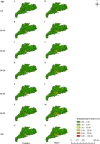High-resolution mapping of age- and gender-specific risk of Clonorchis sinensis infection risk in Guangdong, China: a geostatistical modeling study
- PMID: 38365792
- PMCID: PMC10873974
- DOI: 10.1186/s13071-024-06166-z
High-resolution mapping of age- and gender-specific risk of Clonorchis sinensis infection risk in Guangdong, China: a geostatistical modeling study
Abstract
Background: The latest national survey on the distribution of human parasites in China demonstrated that Guangdong was among the endemic provinces with the highest Clonorchis sinensis infection rates. High-resolution, age- and gender-specific risk maps of the temporal and spatial distributions are essential for the targeted control work.
Methods: Disease data on the prevalence of C. sinensis infection from 1990 onwards, either age- and gender-specific or aggregated across age and gender, were collected through systematic review and four large-scale surveys in Guangdong Province. Environmental and socioeconomic variables were obtained from open-access databases and employed as potential predictors. A Bayesian geostatistical model was developed to estimate the C. sinensis infection risk at high spatial resolution.
Results: The final dataset included 606 surveys at 463 unique locations for C. sinensis infection. Our findings suggested that following an initial increase and stabilization, the overall population-adjusted prevalence had declined to 2.2% (95% Bayesian credible interval: 1.7-3.0%) in the period of 2015 onwards. From 2015 onwards, moderate and high infection risks were found in the northern regions (e.g. Heyuan and Shaoguan cities) and the southern Pearl River Delta (e.g. Foshan, Zhongshan, Zhuhai and Jiangmen cities), respectively. Age- and gender-specific risk maps revealed that males had a higher infection risk than females, and the infection risk was higher in adults compared to children.
Conclusions: Our high-resolution risk maps of C. sinensis infection in Guangdong Province identified the spatial, temporal, age and gender heterogeneities, which can provide useful information assisting tailored control strategies.
Keywords: Clonorchiasis; Guangdong Province; High-resolution mapping; Intervention.
© 2024. The Author(s).
Conflict of interest statement
The authors declare that they have no competing interests.
Figures





References
MeSH terms
Grants and funding
LinkOut - more resources
Full Text Sources

